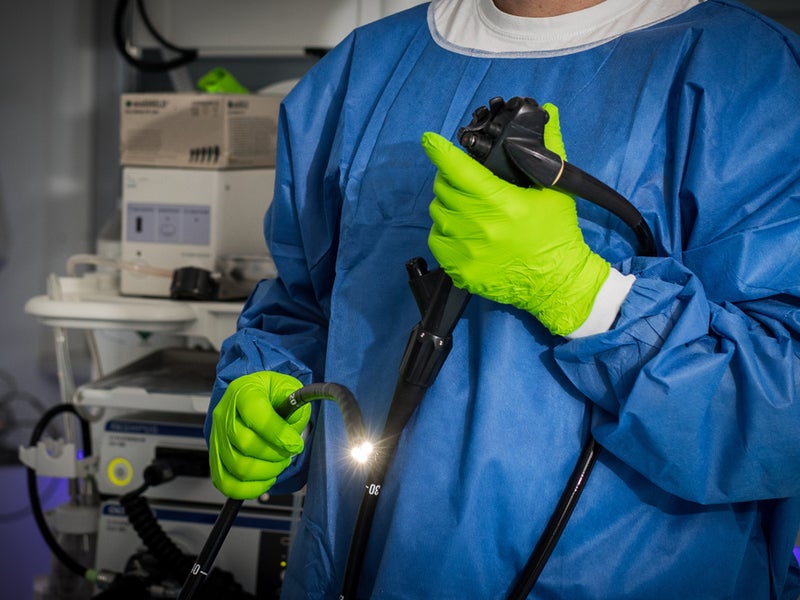
Duodenoscopes are currently used in around 500,000 procedures a year in the US, and are essential tools for diagnosing and treating illnesses in the pancreas and bile ducts. The minimally invasive, re-usable fibreoptic devices are lowered into the upper part of the small intestine via the mouth to scan for signs of disease in a procedure called endoscopic retrograde cholangiopancreatography (ERCP). Unfortunately, they come with a major design flaw that is costing patients their lives – they’re incredibly difficult to keep clean.
Unable to be sterilised by steam heat, which creates cracks in the delicate scopes where bacteria can settle, they are hand-scrubbed and then run through liquid chemical disinfection and/or gas sterilisation. However, due to all of the minute moving parts of a duodenoscope, the devices may still retain microscopic traces of bacteria or tissue after industry-standard cleansing. These can then be inadvertently transferred from patient to patient, causing illness.
A US Food and Drug Administration (FDA) analysis of medical device reports published earlier this year revealed that between October 2018 and March 2019, three patient deaths and 45 patient infections were caused by inadequate reprocessing of duodenoscopes. There were 159 cases of device contamination reported in total.
In a statement, the FDA said: “While the risk of infection transmission cannot be completely eliminated, the benefits of these devices continue to outweigh the risks in appropriately selected patients.”
Recent tests performed by duodenoscope manufacturers Fujifilm, Pentax and Olympus at the FDA’s behest found that one in 20 duodenoscopes retained particles of diseases such as E. coli and pseudomonas aeruginosa.
An individual duodenoscope can cost around $35,000, with annual maintenance costs of $1,451 per scope. The devices last about three years.
How well do you really know your competitors?
Access the most comprehensive Company Profiles on the market, powered by GlobalData. Save hours of research. Gain competitive edge.

Thank you!
Your download email will arrive shortly
Not ready to buy yet? Download a free sample
We are confident about the unique quality of our Company Profiles. However, we want you to make the most beneficial decision for your business, so we offer a free sample that you can download by submitting the below form
By GlobalDataThe story so far
Fujifilm, Pentax and Olympus were ordered to conduct post-market surveillance studies to better understand how duodenoscopes are reprocessed in real-world settings in October 2015. All three manufacturers were issued with warning letters in March 2018 due to failure to provide sufficient data in response to this order, which finally spurred them into action.
In December 2018, the FDA released preliminary data indicating a higher-than-expected duodenoscope contamination rate, which had originally been forecast at less than 0.4% based on culturing trials. In total, 5.4% samples had tested positive for ‘high-concern’ bacteria, and another 3.6% for bacteria of ‘low concern’. That same December, Olympus and a former senior executive pleaded guilty to not reporting adverse events related to duodenoscope infections. The company was fined $80m, plus an additional $5m in criminal forfeiture.
Cut to April 2019, the FDA revealed the three patient deaths and 45 infections that had occurred between October 2018 and March 2019.
In August, the authority urged healthcare providers and manufacturers to transition to duodenoscopes with disposable components to cut down infection risk. The regulator is issuing new post-market surveillance study orders to manufacturers of duodenoscopes with disposable endcaps to see if these reduce the contamination rate.
The FDA also urged healthcare facilities not to rely on the results of tests using adenosine triphosphate (ATP) strips to detect live microbes after duodenoscope cleaning. There are no legally marketed ATP test strips judged to be effective for the assessment of duodenoscope reprocessing at present, and ATP test strip manufacturers have been asked to submit their data to the FDA.
Disposable duodenoscopes
However, the industry may have come up with a solution to the problem. Danish medical device manufacturer Ambu says it is pioneering single-use endoscopic procedures across colonoscopies and gastroscopies as well as duodenoscopies.
The company claims that before the end of September 2020, it will be bringing its disposable duodenoscopes to the medtech market, having announced in May 2019 that the product will be distributed across the US by Cook Medical after FDA clearance.
Disposable, single-use duodenoscopes would entirely bypass the risk of infection proposed by the reusable devices, as there would be no chance of bacterial transfer from patient to patient. They would, of course, lack the eco-friendly credentials of the reusable devices, but given the potential of disposable tech to reduce – or even eliminate – the rates of infection suffered by duodenoscopy patients, this looks like a price worth paying. Ambu CEO Juan Jose Gonzalez said: “We plan to bring single-use endoscopes to patients undergoing ERCP procedures, to reduce the risk of serious cross-contaminations.”
It’s not just Ambu that is working on a disposable duodenoscope; in fact it could face some stiff competition. Boston Scientific began a clinical trial of its Exalt single-use duodenoscope and is hoping to secure 501(k) clearance in the US by the end of 2019, which would allow it to be presented to healthcare providers as substantially equivalent to the reusable duodenoscopes already on the market. A November 2019 FDA panel noted that, while current data is lacking, new duodenoscope designs may well help reduce infections.
Said panel also ruled that proper training of reprocessing personnel was one of the most significant factors when minimising duodenoscope infections. Many people employed to clean scopes simply aren’t doing so to a standard sufficient to avoid infections. It’s unknown how quickly surgeons would be able to transition to disposable devices should they make their way to the market any time soon. The new single-use tools may be a superior product, but unless the re-usable duodenoscope market – worth $150m globally – were forced to fold entirely it’s unlikely hospitals across the US will be rushing to dispose of expensive equipment they’ve invested large sums of money in.
Of course, none of this changes the fact that in just a six-month period, three people lost their lives due to infections from the use of unsterile duodenoscopes.
As FDA devices and radiological health director Jeff Shuren said in a statement earlier this year: “That’s three deaths too many.”






